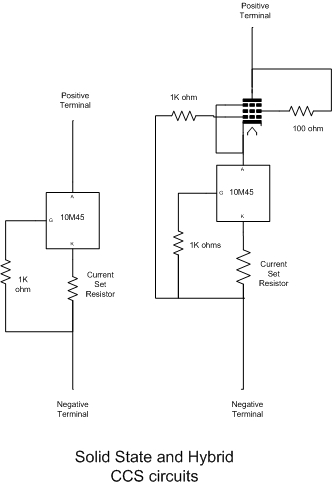The CCS is very useful circuit in tube amplifiers even though they are often made with solid state devices. CCS is the short hand abbreviation for Constant Current Source or Constant Current Sink. The two terms are often used interchangeably and it is possible for the same circuit to be a source or a sink depending on the application. In the ideal form a CCS has only two terminals and will draw the same current no matter how much voltage is across it.

A CCS requires a minimum voltage across it to work. This is called the dropout voltage. This voltage is often only a few volts for a solid state CCS. A vacuum tube (or hybrid) CCS may require over 200 volts however. This is usually undesirable in power amplifier output stage applications. I tested several of the popular audio tubes and a few sweep tubes for use in CCS applications. I used an IXYS chip in the cathode circuit to set the current. I reduced the voltage across the tube and recorded the voltage where the current began to drop. This chart shows that sweep tubes make the best CCS’s.
| Tube Type | 30mA | 50mA | 80mA | 100mA |
|---|---|---|---|---|
| KT-88 Chinese | 100 | 110 | 145 | |
| 6L6RC RCA black plate | 125 | 165 | 205 | |
| 6CA7 Japan | 150 | 195 | 250 | |
| 6V6GT JAN CBS | 160 | 195 | 245 | |
| 5881 GE | 130 | 160 | 208 | |
| 5932 SYL | 126 | 155 | 200 | |
| 6Y6 | 76 | 92 | 104 | |
| 6AV5GA GE | 65 | 85 | 105 | |
| 6AU5 GE | 72 | 90 | 112 | |
| 6LW6 GE | 36 | 40 | 50 | 55 |